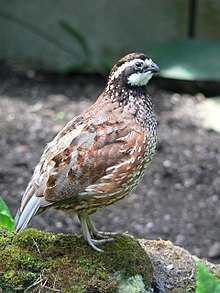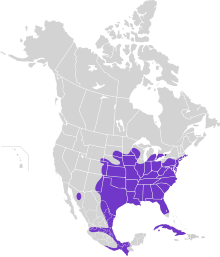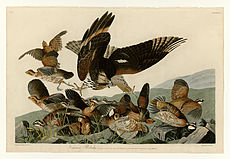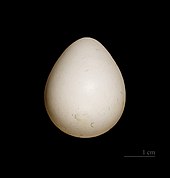
Quail is a collective name for several genera of mid-sized birds generally placed in the order Galliformes. The collective noun for a group of quail is a flock, covey, or bevy.
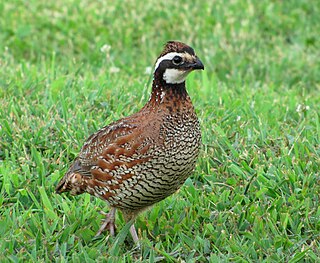
The New World quail are small birds related to the Old World quail, and are named for their similar appearance and habits. The American species are in their own family, the Odontophoridae, whereas Old World quail are in the Phasianidae. The family ranges from Canada through to southern Brazil, and two species, the California quail and the bobwhite quail, have been successfully introduced to New Zealand. The stone partridge and Nahan's partridge, both found in Africa, seem to belong to the family. Species are found across a variety of habitats from tropical rainforest to deserts, although few species are capable of surviving at very low temperatures. The 34 species are placed in 10 genera.
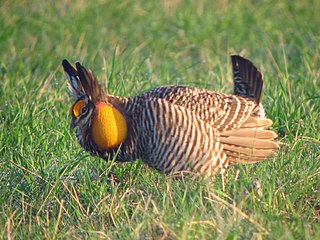
The greater prairie chicken or pinnated grouse, sometimes called a boomer, is a large bird in the grouse family. This North American species was once abundant, but has become extremely rare and extirpated over much of its range due to habitat loss. Conservation measures are underway to ensure the sustainability of existing small populations. One of the most famous aspects of these creatures is the mating ritual called booming.

The greater sage-grouse, also known as the sagehen, is the largest grouse in North America. Its range is sagebrush country in the western United States and southern Alberta and Saskatchewan, Canada. It was known as simply the sage grouse until the Gunnison sage-grouse was recognized as a separate species in 2000. The Mono Basin population of sage grouse may also be distinct.

The Gunnison grouse, Gunnison sage-grouse or lesser sage-grouse is a species of grouse endemic to the United States. It is similar to the closely related greater sage-grouse in appearance, but about a third smaller in size, with much thicker plumes behind the head; it also has a less elaborate courtship dance. It is restricted in range to southwestern Colorado and extreme southeastern Utah, with the largest population residing in the Gunnison Basin region in Colorado. Despite being native to a country where the avifauna is relatively well known, it was overlooked until the 1990s due to the similarities with the sage grouse, and only described as a new species in 2000—making it the first new avian species to be described from the USA since the 19th century. The description of C. minimus as a separate species is supported by a molecular study of genetic variation, showing that gene flow between the large-bodied and the small-bodied birds is absent.
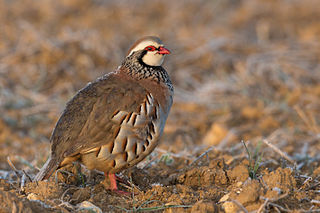
The red-legged partridge is a gamebird in the pheasant family Phasianidae of the order Galliformes, gallinaceous birds. It is sometimes known as French partridge, to distinguish it from the English or grey partridge. The genus name is from Ancient Greek alektoris a farmyard chicken, and rufa is Latin for red or rufous.
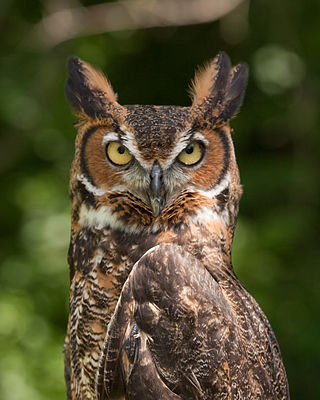
The great horned owl, also known as the tiger owl, or the hoot owl, is a large owl native to the Americas. It is an extremely adaptable bird with a vast range and is the most widely distributed true owl in the Americas. Its primary diet is rabbits and hares, rats and mice, and voles, although it freely hunts any animal it can overtake, including rodents and other small mammals, larger mid-sized mammals, birds, reptiles, amphibians, and invertebrates. In ornithological study, the great horned owl is often compared to the Eurasian eagle-owl, a closely related species, which despite the latter's notably larger size, occupies the same ecological niche in Eurasia, and the red-tailed hawk, with which it often shares similar habitat, prey, and nesting habits by day, thus is something of a diurnal ecological equivalent. The great horned owl is one of the earliest nesting birds in North America, often laying eggs weeks or even months before other raptorial birds.

The yellow warbler is a New World warbler species. Yellow warblers are the most widespread species in the diverse genus Setophaga. The species can be found throughout most of North America and migrates to wintering grounds from southern California to the Amazon region, Bolivia, and Peru.

The spotted owl is a species of true owl. It is a resident species of old-growth forests in western North America, where it nests in tree hollows, old bird of prey nests, or rock crevices. Nests can be between 12 and 60 metres high and usually contain two eggs. It is a nocturnal owl which feeds on small mammals and birds. Three subspecies are recognized, ranging in distribution from British Columbia to Mexico. The spotted owl is under pressure from habitat destruction throughout its range, and is currently classified as a near-threatened species.
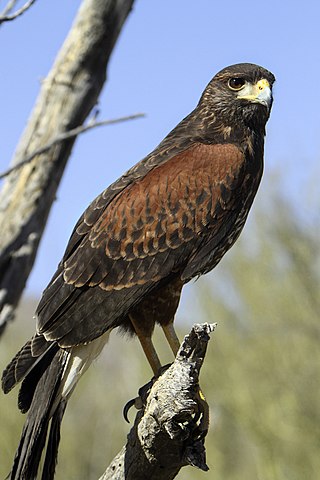
The Harris's hawk, formerly known as the bay-winged hawk, dusky hawk, and sometimes a wolf hawk, and known in Latin America as peuco, is a medium-large bird of prey that breeds from the southwestern United States south to Chile, central Argentina, and Brazil. This bird is sometimes reported to be at large in Western Europe, especially Britain, but it is a popular species in falconry and these records almost invariably all refer to escapes from captivity.

The king quail, also known as the blue-breasted quail, Asian blue quail, Chinese painted quail, or Chung-Chi, is a species of Old World quail in the family Phasianidae. This species is the smallest "true quail", ranging in the wild from southern China, South and Southeast Asia to Oceania, south to southeastern Australia, with 9 different subspecies. A failed attempt was made to introduce this species to New Zealand by the Otago Acclimatisation Society in the late 1890s. It is quite common in aviculture worldwide, where it is sometimes misleadingly known as the "button quail", which is the name of an only very distantly related family of birds, the buttonquails.
Tall Timbers Research Station and Land Conservancy is a research and learning facility located in northern Leon County, Florida, just off County Road 12 on the north side of Lake Iamonia. Tall Timbers researches the areas of fire ecology, resource management, forestry, game bird management, and vertebrate ecology.

The scaled quail, also commonly called blue quail or cottontop, is a species of the New World quail family. It is a bluish gray bird found in the arid regions of the Southwestern United States to Central Mexico. This species is an early offshoot of the genus Callipepla, diverging in the Pliocene.

Sprague's pipit is a small songbird (passerine) in the family Motacillidae that breeds in the short- and mixed-grass prairies of North America. Migratory, it spends the winters in the southwestern United States and northern Mexico. Sprague's pipits are unusual among songbirds in that they sing high in the sky, somewhat like a goldfinch or skylark. It is more often identified by its distinctive descending song heard from above than by being seen on the ground. Males and females are cryptically coloured and similar in appearance; they are a buffy brown with darker streaking, slender bills and pinkish to yellow legs. Sprague's pipit summer habitat is primarily native grasslands in the north central prairies of the United States and Canada. The species was named after the botanical illustrator Isaac Sprague.
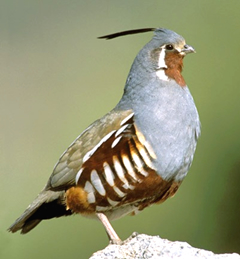
The mountain quail is a small ground-dwelling bird in the New World quail family. This species is the only one in the genus Oreortyx, which is sometimes included in Callipepla. This is not appropriate, however, as the mountain quail's ancestors have diverged from other New World quails earlier than the bobwhites, no later than 6 mya.
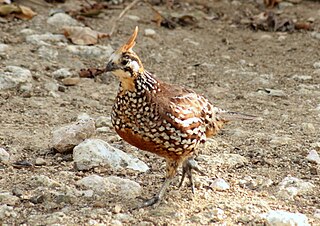
The crested bobwhite is a species of bird in the family Odontophoridae. It is found in northern South America, extending through Panama to just reach Costa Rica. It also occurs on Aruba and the Netherlands Antilles. Its natural habitats are subtropical or tropical dry shrubland, subtropical or tropical seasonally wet or flooded lowland grassland, and heavily degraded former forest.

The Gulf of California xeric scrub is a xeric shrubland ecoregion of Mexico's Baja California Peninsula.

The spot-bellied bobwhite is a ground-dwelling bird in the New World quail family. It is sometimes considered to be conspecific with the crested bobwhite, Colinus cristatus. As the latter species expands north into Costa Rica, it is likely that the two species will overlap in range in the future, but the Costa Rican subspecies of the spot-bellied is the least similar to the crested.

The cactus wren is a species of wren that is endemic to the deserts of the southwestern United States and northern and central Mexico. It is the state bird of Arizona, and the largest wren in the United States. Its plumage is brown, with black and white spots as markings. It has a distinctive white eyebrow that sweeps to the nape of the neck. The chest is white, whereas the underparts are cinnamon-buff colored. Both sexes appear similar. The tail, as well as flight feathers, are barred in black and white. Their song is a loud raspy chirrup; akin in the description of some ornithologists to the sound of a car engine that will not start. It is well-adapted to its native desert environment, and the birds can meet their water needs from their diet which consists chiefly of insects, but also of some plant matter. The cactus wren is a poor flier and generally forages for food on the ground. Ornithologists generally recognize seven subspecies, with the exact taxonomy under dispute.

Buenos Aires National Wildlife Refuge provides 117,107 acres (47,392 ha) of habitat for threatened and endangered plants and animals. This refuge, in Pima County, Arizona, was established in 1985.
